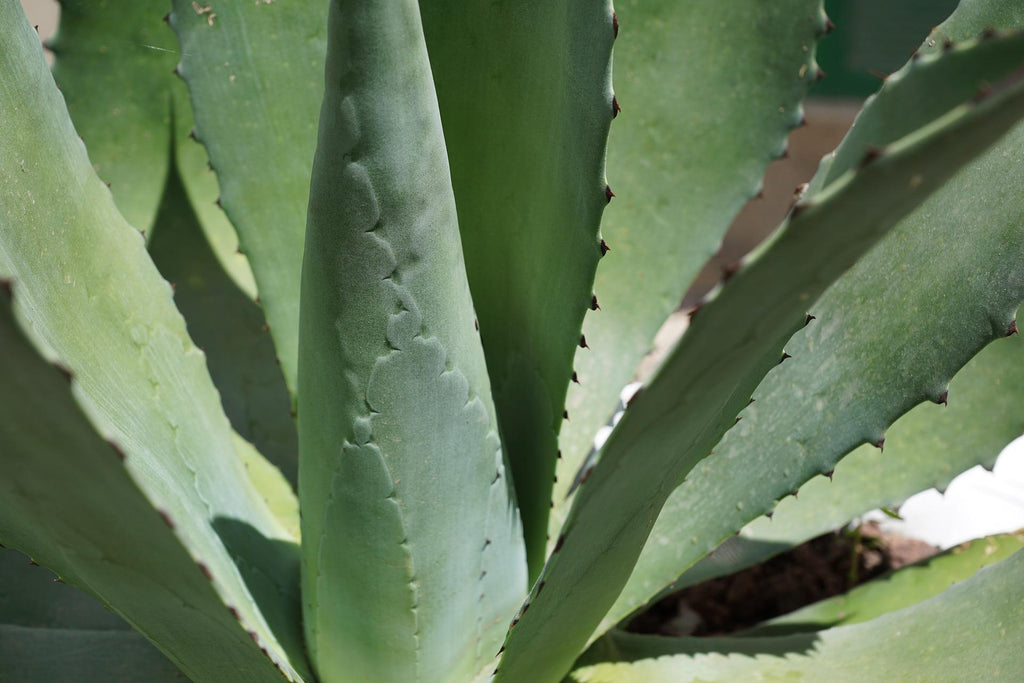Agave plants may be a familiar sight if you live in the west. I often see agave on my walks in Oakland planted in many front gardens. It is a very distinct and dramatic looking plant with thick triangular shaped sharp leaves spiraling from the center to form a rosette. Often there are pups springing up at the base. Depending on the variety the agave can grow to be rather large both in terms of diameter of the plant and the size of a single leaf.
 Image by Frauke Feind from Pixabay
Image by Frauke Feind from Pixabay
Native to hot and arid areas of the Americas, Agave has been used for centuries as a source of food, tools, and fiber. Because of the often harsh climate it grows in, it’s a very slow growing plant. It has evolved to best utilize and save the scarce resource of water in the desert.
The fibrous leaves store water internally and are armed with external spikes along the edge of the thick, waxy leaf. Both the waxiness and the spikes discourage predators and water seekers. The spikes are so sharp and durable, indiginous peoples throughout the Americas have used them as tools, particularly as awls and sewing needles, for thousands of years.
Many species of agave bloom only once in their lifetime. A common name for one of the species is Century Plant. As the name implies, it lives close to a century before it blooms and then the whole plant dies.
 Image by Anja-#pray for ukraine# #helping hands# stop the war from Pixabay
Image by Anja-#pray for ukraine# #helping hands# stop the war from Pixabay
Because of the heat in most areas where agave grows, the plant often blooms at night. Being night blooming cuts down on the available pollinators. Bats have filled this niche, including a bat that evolved and specialized alongside the agave plant to feed on the nectar and pollinate the plant as it’s main food source.
Agave has long served as a resource - tools, food, nectar, and fiber - for people living in the regions where it grows. More recently, it is farmed to harvest the nectar to create vegan sweetener, tequila and mezcal mostly for markets in North America and the global north.
Agave faces many issues that other mono-crops face. The harvest of agave for nectar means that the plant is prevented from flowering, and all of the leaves are cut away exposing the core of the plant where the majority of the nectar is readying itself for the bloom. This means that the pollinators who rely on the nectar are denied this source of sustenance. Many bats are killed as pests, which decreases the availability of pollinators for agave and other plants that rely on bats.
The long growing period before the plant can be harvested, boom and bust periods are inevitable. The growth cycle makes this inevitable, and the farmers have to hope that their harvest coincides with a time when the prices are high and their work and patience will be rewarded. Unfortunately, the harvest can also coincide with a time when the market is flush with agave products driving down the price the farmer will receive.
We are proud to say that we’ve sought out sustainable and equitable sources for many of our products and raw materials like agave.
Our Agave Fiber Cloths are sourced from co-operatives where the cloths are woven by artists in the local community. The cells in these exfoliating cloths expand when moistened and are great at gently removing the dead skin from everywhere on your body. As a bonus, the cloths can be machine washed and will last for a year or two. Because they are made of natural fibers, the cloth can be composted when you are ready to part with it.
Our newly reformulated Olive Oil & Shea Butter Sugar Scrub contains agave nectar. Along with its high moisture content, agave is rich in vitamins A, B, C, D & K agave and has anti-inflammatory properties.




Leave a comment